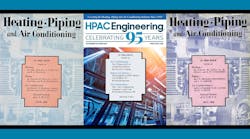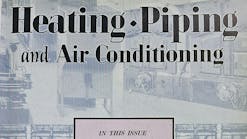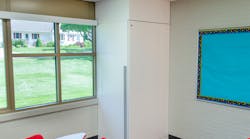By CHRIS MARASCO, Modine Manufacturing
COVID-19 has been a continuing disruptor over the past year and a half. The nation not only saw stores and other businesses scramble to find solutions for the ever-increasing pandemic guidelines, but schools also struggled to find a way to educate students safely. This resulted in a massive number of schools opting for online learning during the 2020-21 school year.
While the pandemic created hurdles for many, it introduced a new sense of urgency when it came to indoor air quality (IAQ) and the need to improve the overall sanitation of schools. Enhancing IAQ continues to be a focus amongst the media and various political affiliations due to concerns about the Delta and other variants of COVID-19. School districts are no different with students fully emersed in in-person learning for the 2021-22 school year.
With rising concerns over harmful airborne pathogens negatively affecting students and faculty, HVAC manufacturers have been placed under a microscope and charged with developing solutions to improve IAQ within school facilities. As an increased measure, these solutions need to also create an atmosphere that allows the student to continue performing at a high level.
Mechanical HVAC equipment continues to be the best option and resource for enhancing IAQ in school facilities and other commercial environments. HVAC units come standard with capabilities that help combat airborne pathogens, but they can be upgraded, in most cases, to increase exchange rates and keep energy usage at a minimal. Many manufacturers have products that are specifically made for school usage, which includes specifications such as noise minimalization.
Filtration, ventilation, and dehumidification are key areas that need to be focused on when it comes to choosing focal points for improvement. Improving these areas will ultimately enhance or improve a school’s IAQ.
Filtering Out Pathogens
By their very nature, school facilities are typically packed with both children and adults. Because of this, filtering the air is necessary to prevent the spread of pathogens. It is recommended for facilities to follow the lead of the American Society of Heating, Refrigerating and Air-Conditioning Engineers (ASHRAE) when establishing HVAC filtering guidelines. ASHRAE recommends using MERV 13 filtration for most applications. The MERV 13 rating means the filters can remove 90% of particles between 1-10 microns in size.
Needlepoint Bipolar Ionization and Ultraviolet (UV) lights are other tools that can be used to improve IAQ. Bipolar Ionization allows positive and negative ions to be delivered via the ventilation system to attach to airborne particulates, cluster, and get them filtered from the air. As for UV lights, ASHRAE has been recommending UV lights for many years because Ultraviolet germicidal energy (UV-C) has been shown to inactivate viruses, bacteria, and fungi.
Venting Contaminated Air Regarding ventilation, the World Health Organization (WHO) states, “the risk of the spread of the (COVID-19) virus is higher in crowded and poorly ventilated spaces where people spend long periods of time together in close proximity. Improving indoor ventilation can reduce the risk of the virus spreading indoors.” The statement is heightened in school facilities, where students regularly interact with one another and stand in close proximately throughout the day.
Controlled ventilation is a key option to help circulate air throughout an educational facility. Controlled ventilation is the rate at which an HVAC unit can push fresh air indoors. In most cases, the air outdoors is fresher than indoor air. School leaders looking to improve IAQ need to emphasize increasing exchange rates to ensure facilities are bringing in as much outdoor air as possible. Mechanical HVAC units have control systems that can be utilized to set the rate at which outside air is pushed indoors while extracting indoor air.
Maintaining Proper Humidity Levels
When the air in a room is extremely sticky or dry, students can be left feeling uncomfortable. While this affects learning, it can also be creating a much bigger problem underneath. Humidity levels play a large role in the development of pathogen growth. Controlling humidity levels is vital in combating the organic growth of mold and mildew. Mechanical HVAC equipment is developed to handle humidity when replacing the air inside with fresh outdoor air. Relative humidity levels should be between 40% and 60% to prevent organic growth and keep students and faculty members comfortable.
Regular Maintenance
Regular maintenance is important when operating a mechanical HVAC unit. Keeping your HVAC equipment properly serviced will increase longevity, provide for proper operational performance, and reduce the probability of failure. In addition, this will also increase the efficiency of the unit and help ensure it is running at peak levels. A regularly serviced HVAC unit produces the best opportunity to enhance IAQ and maximize the overall efficiency of the school facility.
##########
Based in Franklin WI, the author is a product manager at Modine Manufacturing Company, which he joined in 2015 as an application engineer. Modine specializes in thermal management systems and components, bringing highly engineered heating and cooling components, original equipment products, and systems to diversified global markets through its four complementary segments: CIS; BHVAC; HDE; and Automotive.









